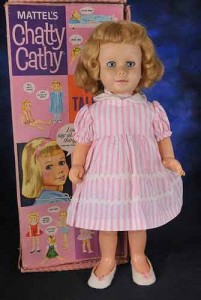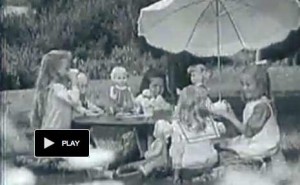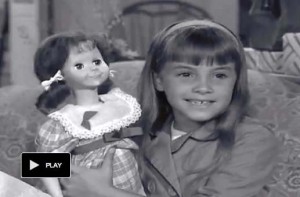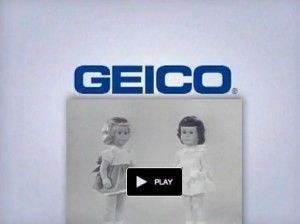“Chatty Cathy” – a designation for a person who talks a lot while having little to say.

The expression “Chatty Cathy,” is used to describe a person who talks a lot – usually about very little. The expression comes to us directly from the extremely popular doll of the same name made by the Mattel toy company from 1959 to 1966. The doll “talked” by virtue of a rugged miniature phonograph player and record permanently placed inside her abdomen.
A ringed pull cord was located on the doll’s back. When pulled, it would wind an internal spring mechanism that would drive the record player and select, at random, one of eleven doll-appropriate phrases. Later, this number was upped to 18 expressions, and finally, a version of the doll came with a set of five insertable mini-records that together gave the blabby moppet a vocabulary of over 100 expressions.
And when any of the Chatty Cathy dolls – Mattel eventually marketed a whole gang of them – were made to talk, the effect was … well, hands down creepy!

As a preschooler, I personally remember pulling the cord of my sister’s doll and hearing THE VOICE – tinny, slurred, cheerful yet flat at the same time, unlike any real human voice I’d ever heard. And talk about non-responsiveness. The TV commercials for Cathy promised a perfect tiny friend, a miracle doll come to life, but all I experienced was an expressionless, unconnected manikin whose lips did not move.
My weirdest Chatty Cathy encounter was one time when my sister, probably inspired by the above commercial, invited her friends over with their Chatty Cathys for a tea party, wherein the dolls all “conversed” with each other at once, with the little real girls furiously pulling away at their respective dolls’ string cords. Talk about Dementia in Toyland.
In a sense, Chatty Cathy was an early embodiment of what roboticists today might term the “uncanny valley” syndrome, i.e., “… a range of appearances, mannerisms, and/or behaviors subtly different from humanoid in an otherwise humanoid figure that may cause negative reactions, such as fear, discomfort, or revulsion.” (From Wiktionary.)
Well, that’s putting it a little harshly for what is after all just a doll. But Rod Sterling, the driving force behind the Twilight Zone TV series, was on to Chatty Cathy and her spookiness.

A November 1, 1963 episode titled Living Doll features Talky Tina, a murderous toy that could have easily been Chatty Cathy’s evil twin sister. And to make sure viewers got the point, Sterling cast June Foray, who provided the voice of the original Chatty Cathy, to voice Talky Tina.
Geico, the insurance company, also does a good job of capturing Cathy’s power to rattle.

And just as Hal in Stanley Kubrick’s 2001: A Space Odyssey (1968) taught me to be careful about what I say in front of my computer (… hey, you never know), Talky Tina warned generations of parents to keep an eye out for unexpectedly malevolent toys.